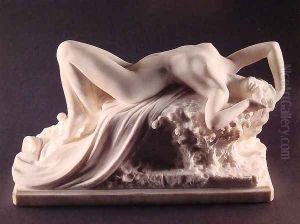Constantino Barbella Paintings
Constantino Barbella was an Italian sculptor born on October 17, 1852, in Chieti, Abruzzo. He is celebrated for his detailed and expressive works in bronze and terracotta, capturing the essence of his regional Italian heritage with a particular focus on the life and people of Abruzzo. Barbella's artistic journey began under the guidance of his father, Raffaele Barbella, a respected sculptor in his own right, which provided Constantino with an early exposure to the world of art and craftsmanship.
After honing his skills in his father's workshop, Barbella pursued formal education at the Naples Academy of Fine Arts, where he was influenced by the prevailing styles of the time, including Realism and Neoclassicism. His studies were enriched by the vibrant artistic atmosphere of Naples, a city known for its rich cultural heritage and history. Despite the influence of these broader movements, Barbella's work remained deeply rooted in the traditions and daily life of his native Abruzzo, a theme that would characterize much of his career.
Barbella's sculptures are noted for their intricate detail, dynamic forms, and the ability to convey deep emotions and narratives. He excelled in portraying everyday scenes and figures, from peasants and fishermen to children and animals, imbuing them with a sense of dignity and humanity. His works were not only artistic achievements but also documents of the social and cultural contexts of 19th-century Italy, particularly of the rural communities in Abruzzo.
Throughout his career, Constantino Barbella achieved recognition both in Italy and internationally. He participated in numerous exhibitions, winning awards and commissions that further established his reputation. Despite his success, Barbella remained deeply connected to his roots in Chieti, where he eventually established his own school of sculpture, fostering the next generation of artists and ensuring the continuation of his artistic legacy.
Barbella's contributions to Italian art were not limited to his sculptures; he was also instrumental in promoting the arts in Abruzzo, contributing to the cultural vitality of the region. His legacy is preserved in several public and private collections, and his work continues to be celebrated for its technical mastery and poignant portrayal of Italian life. Constantino Barbella passed away on December 14, 1925, leaving behind a rich body of work that endures as a testament to his skill and passion for art.
